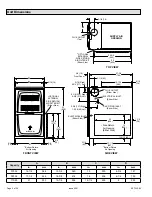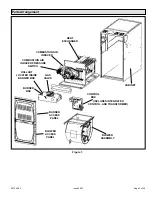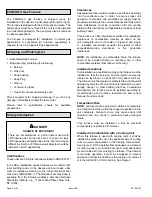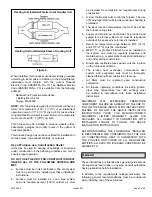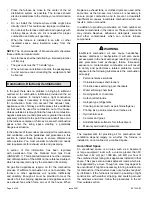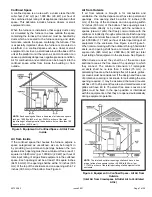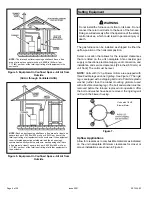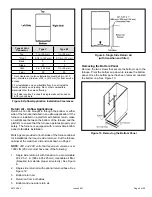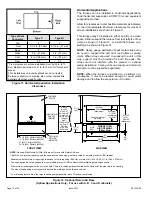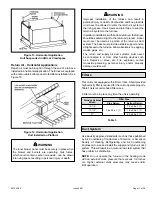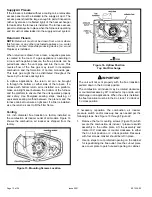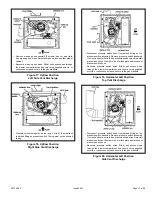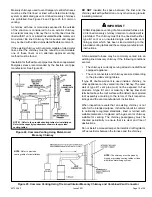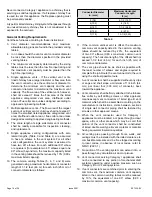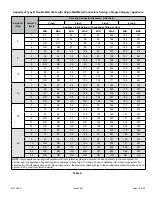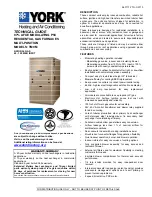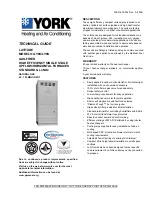
507335-02
Page 4 of 39
Issue 2001
80G2UH-V Gas Furnace
The 80G2UH-V gas furnace is shipped ready for
installation in the upflow or horizontal position (left or right).
The furnace is shipped with the bottom panel in place. The
bottom panel must be removed if the unit is to be installed
in a horizontal application. The panel may also be removed
in upflow applications.
The furnace is equipped for installation in natural gas
applications. A conversion kit (ordered separately) is
required for use in propane/LP gas applications.
Shipping and Packing List
1 - Assembled Gas Furnace
1 - Bag assembly containing the following:
2 - Screws
3 - Wire nuts
1 - Snap bushing
1 - Snap Plug
1 - Wire tie
1 - Vent warning label
1 - Owner’s manual and warranty card
Check equipment for shipping damage. If you find any
damage, immediately contact the last carrier.
Please refer to specification sheets for available
accessories.
Safety Information
DANGER OF EXPLOSION!
There are circumstances in which odorant used with
LP/Propane gas can lose its scent. In case of a leak,
LP/Propane gas will settle close to the floor and may be
difficult to smell. An LP/Propane leak detector should be
installed in all LP applications.
DANGER
Certifications
These units are CSA International certified to ANSI Z21.47.
In the USA, installation of gas furnaces must conform with
local building codes. In the absence of local codes, units
must be installed according to the current National Fuel
Gas Code (ANSI-Z223.1). The National Fuel Gas Code is
available from the following address: American National
Standards Institute, Inc., 11 West 42nd Street, New York,
NY 10036.
Clearances
Adequate clearance must be made around the air openings
into the vestibule area. In order to ensure proper unit
operation, combustion and ventilation air supply must be
provided according to the current National Fuel Gas Code.
Vent installations must be consistent with the venting
tables (in this instruction) and applicable provisions of local
building codes.
This furnace is CSA International certified for installation
clearances to combustible material as listed on the
unit nameplate and in the tables in Figure 8 and Figure
11. Installers should also consider the greater of either
accessibility/service clearances or fire protection
clearances.
NOTE:
For installation on combustible floors, the furnace
shall not be installed directly on carpeting, tile, or other
combustible material other than wood flooring.
Installed Locations
For installation in a residential garage, the furnace must be
installed so that the burner(s) and the ignition source are
located no less than 18 inches (457 mm) above the floor.
The furnace must be located or protected to avoid physical
damage by vehicles. When a furnace is installed in a public
garage, hangar, or other building that has a hazardous
atmosphere, the furnace must be installed according to
recommended good practice requirements and current
National Fuel Gas Code.
Temperature Rise
NOTE:
Furnace must be adjusted to obtain a temperature
rise (high and low fire) within the range(s) specified on the
unit nameplate. Failure to do so may cause erratic limit
operation and may result in premature heat exchanger
failure.
This furnace must be installed so that its electrical
components are protected from water.
Installed in Combination with a Cooling Coil
When this furnace is used with cooling units, it shall be
installed in parallel with, or on the upstream side of, cooling
units to avoid condensation in the heating compartment.
See Figure 2. With a parallel flow arrangement, a damper
(or other means to control the flow of air) must adequately
prevent chilled air from entering the furnace. If the damper
is manually operated, it must be equipped to prevent
operation of either the heating or the cooling unit, unless it
is in the full HEAT or COOL setting. See Figure 2.


